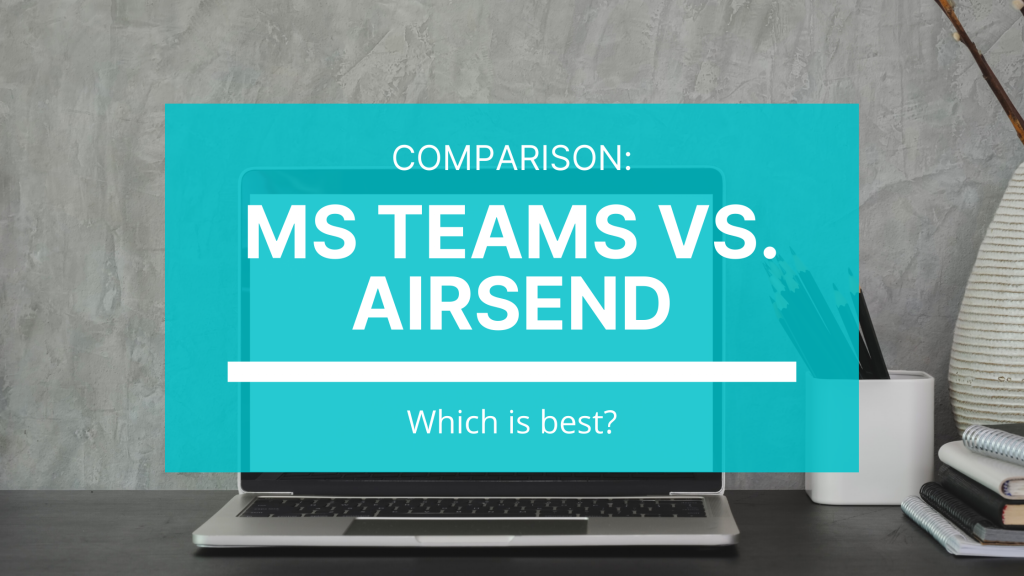
Microsoft Teams or AirSend? Which platform should you choose for your business?
Now more than ever, every business needs to find the right tools to stay connected with its team and customers. This blog post is a head-to-head comparison of one of the biggest players in the digital workspace market – Microsoft Teams – and an up-and-coming new arrival – AirSend.
We’re going to go over how each digital workspace performs in four categories, with clear pros and cons on both sides, so that you can make the best decision for your business. The four categories are:
- Pricing
- UI Design
- UX
- Features & Capabilities
Microsoft Teams vs. AirSend: Pricing
As mentioned before, Microsoft Teams is already a major player in the digital workspace market, while AirSend is still up-and-coming. That’s probably why MS Teams is definitely the more expensive option.
The free version of Microsoft Teams gives you 2 GB of personal storage and 10 GB of shared storage. The free version of Airsend (currently the Pro version – which AirSend is offering free for one year) gives each user 100 GB of storage and does not differentiate between personal or shared.
Additionally, you can only get Microsoft Teams free if you sign up for Office 365 as a new user. If you’re already using Office 365, Teams is not free but included in certain paid plans, the cheapest being $12.50/user/month.
In comparison, AirSend is currently offering AirSend Pro free for one year for anyone who signs up. You can even sign up for multiple accounts if you have more than one email address.
Pricing: AirSend wins.
Microsoft Teams vs. AirSend: UI Design
User interface can be a matter of personal preference.
AirSend’s UI Design is very simple and clear. You have the main page where you see all of your channels and where you can create new channels. And once you click into a channel, the chat, actions, files, and Wiki are all in the same place in each channel. It’s also easy to access the channel settings to change the name of the channel, background, logo, and other settings.
With MS Teams’ UI Design, things get more complicated. This might be because Teams has more features (more on this in a bit). But there is some redundancy in terms of the chat tab, and then the messaging section in the teams section, and then the messaging within channels within the teams. On the plus side, there is more ability to customize what features goes where in the MS Teams UI. On the other hand, you cannot customize the channel backgrounds and logos like you can in AirSend – read: no custom branded channels in MS Teams.
UI Design: it’s a tie.
Microsoft Teams vs. AirSend: UX
Of course, UX largely piggybacks off of UI design, so we’re going to continue our above discussion with some additional points.
AirSend’s simplicity allows for a new user to jump in and get the hang of things quickly. Microsoft Teams, while offering a greater amount of flexibility and more features, can be overly complicated and difficult to understand.
For example, when you upload a file in AirSend – it shows up in the location that you uploaded it and nowhere else. Then you can drag and drop it to share. Or you can upload directly to the chat, and it will show up in the attachments folder of that channel. That is easy to understand for the lay user.
In contrast, when you upload a file in Microsoft Teams, it shows up in three places: the chat, SharePoint, and OneDrive. And there are even two separate links (one from SharePoint and one from OneDrive) that point to the same file. There’s more of that redundancy we mentioned earlier which makes it seem like MS Teams’ UI and UX was not very well thought-out.
UX: AirSend wins.
Microsoft Teams vs. AirSend: Features and Capabilities
If it’s app integrations you’re looking for, MS Teams wins hands down. It has 503 total app integrations, some popular ones being Microsoft Office Suite, Trello, and GitHub. AirSend has Office 365 integration, which allows you to easily edit documents, and email integration so that you can still use AirSend to communicate with clients who don’t have an AirSend account. But that’s about it.
On the other hand, AirSend has some built-in capabilities that Microsoft Teams does not have. First, it’s easy to work with people outside your organization with AirSend. Just create a new channel and invite them to the channel using their email address. With MS Teams – it’s hoop after hoop just to get permission to share things with people outside your org. If you have and IT manager who can configure that for you – great. If not, good luck!
AirSend also has a built-in actions management section, which MS Teams does not have but makes up for with its Trello integration. And AirSend gives you the ability to easily create public channels where anyone who has a link to the channel can join. This is great for businesses who want to build a community or host a public Q&A channel.
Features and Capabilities: it depends.
Conclusion?
As you can see, choosing between Microsoft Teams and AirSend for your business greatly depends on your current set-up, level of technical knowledge, and business needs. If you’re a heavy Office 365 user that doesn’t mind a steeper learning curve and needs more integrations – Microsoft Teams is the way to go. If you’re looking for a simple, easy-to-use digital workspace solution that allows you to work with both your team and outside clients with ease – then choose AirSend.
Have questions or want to learn more? Come talk to us here.
AirSend is a versatile digital workspace to share files, send messages, and complete tasks. Click here to see how AirSend can help you.